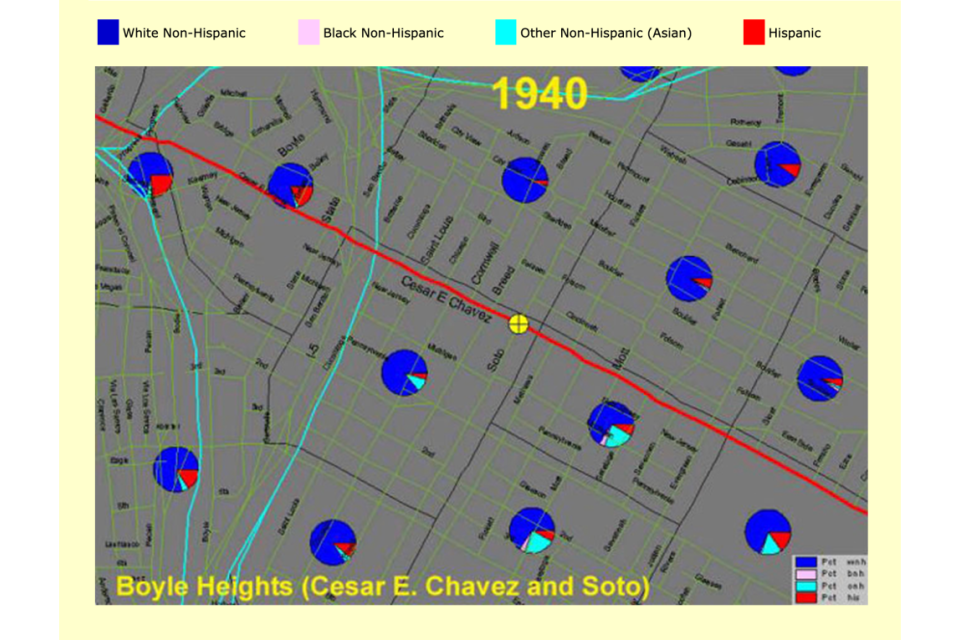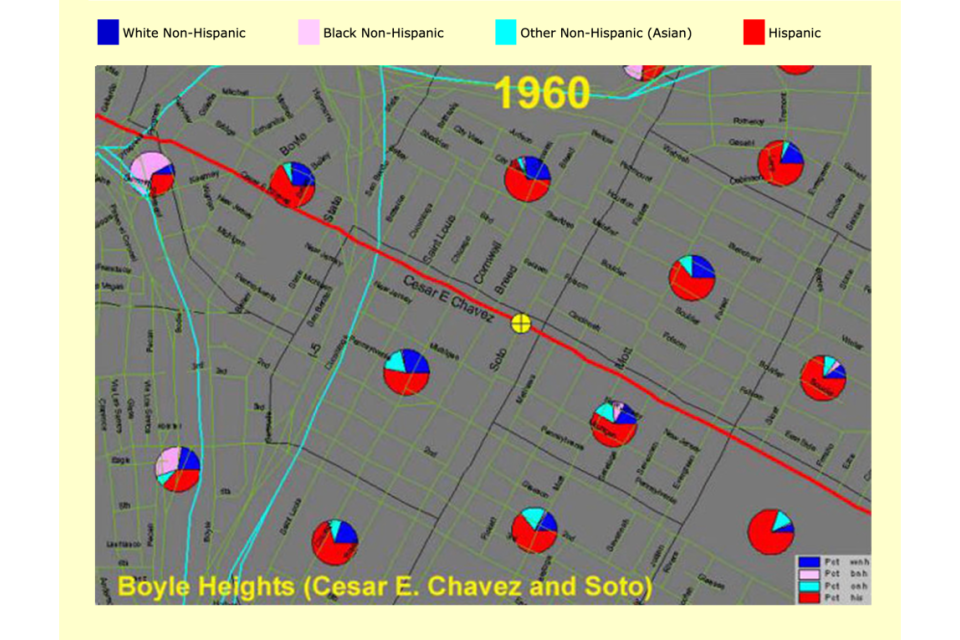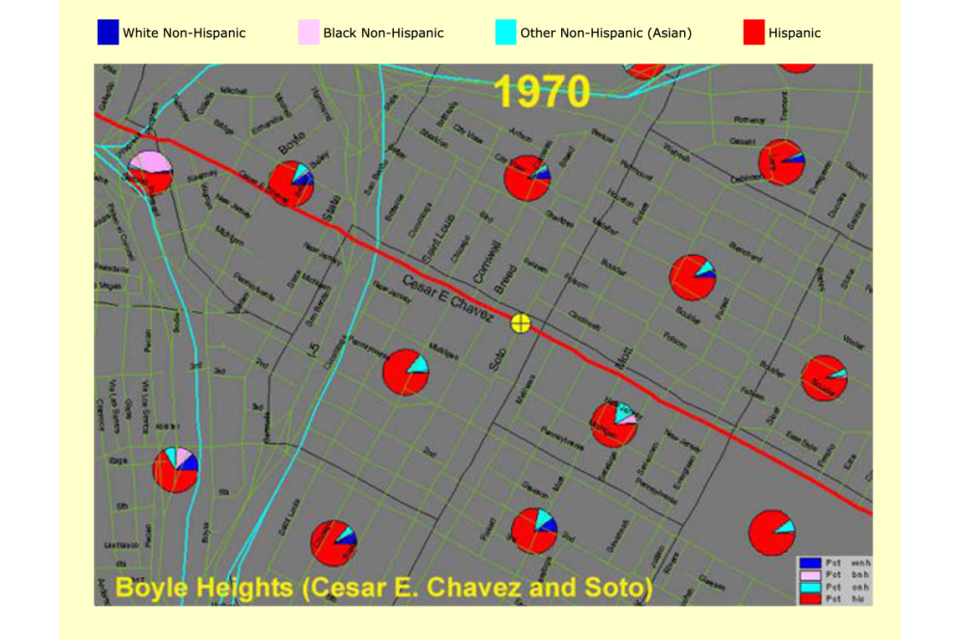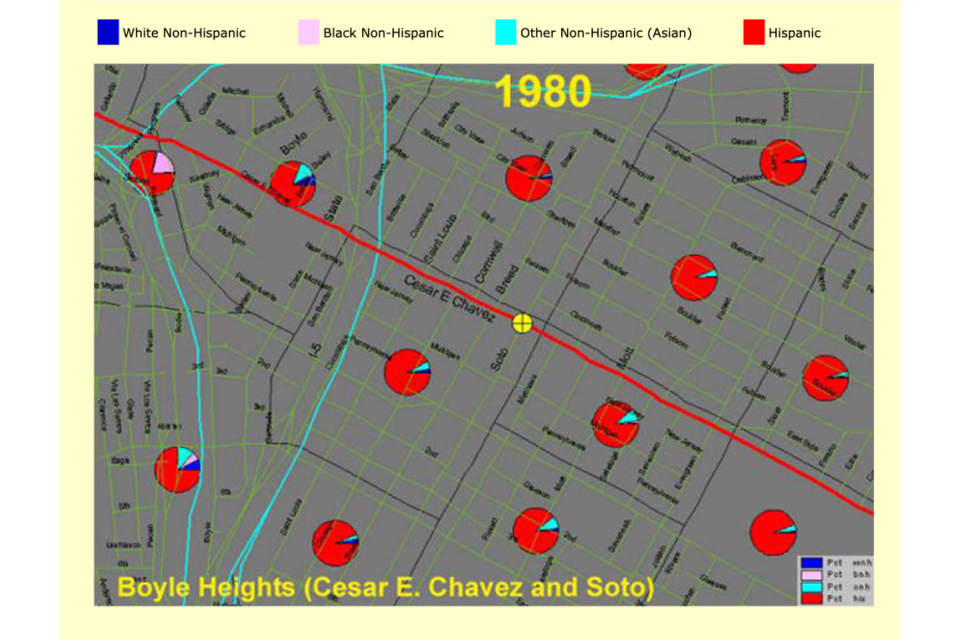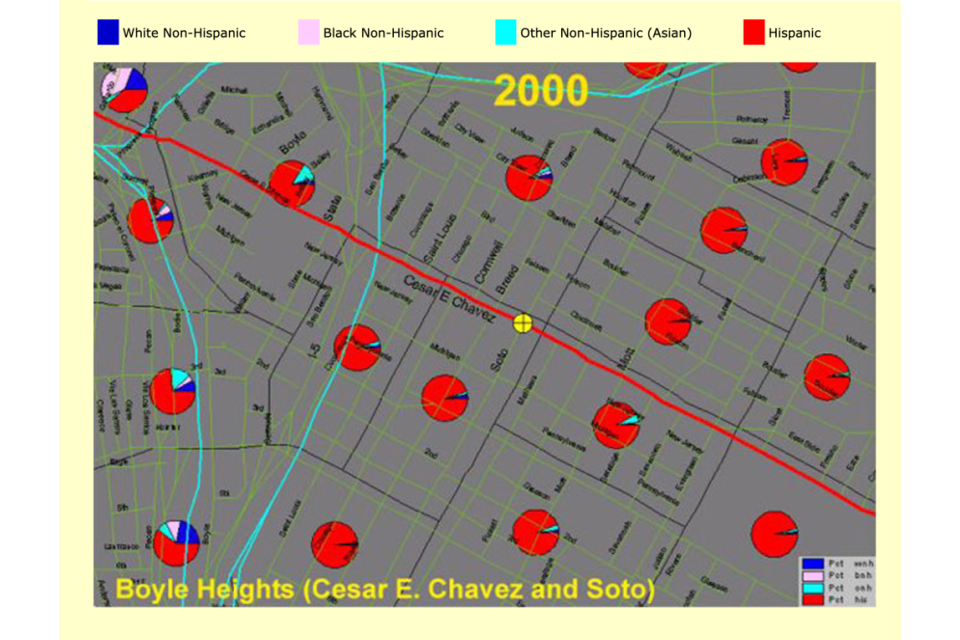Timeline prepared in consultation with: Gilbert Estrada, Michael Engh, S.J., Wendy Elliott-Scheinberg, Art Hansen, Lloyd Inui, Mary MacGregor-Villareal, Matt Roth, James Rojas, Vicki Ruiz, George Sanchez, and Raul Vasquez.

Past Exhibition
Boyle Heights
The Power of Place
History
Explore resources produced for the exhibition—a map of the neighborhood, timeline of significant dates, and demographic maps that show the changes to the community over decades.
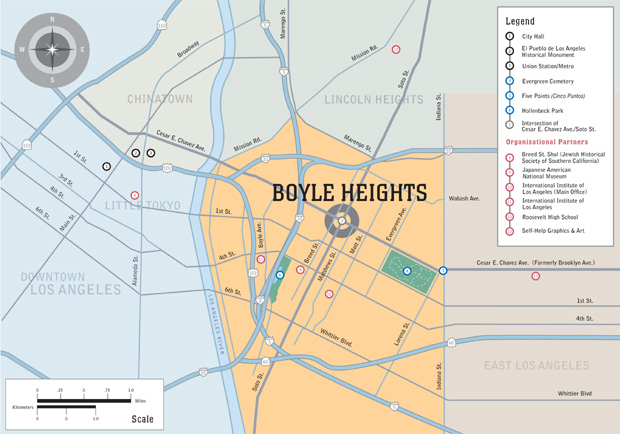
Map of Boyle Heights in Los Angeles, California
History
September 08, 2002 - February 23, 2003
Japanese American National Museum
Weingart Foundation Gallery
100 N. Central Ave.
Los Angeles, CA 90012
History
Explore resources produced for the exhibition—a map of the neighborhood, timeline of significant dates, and demographic maps that show the changes to the community over decades.

Map of Boyle Heights in Los Angeles, California
History
September 08, 2002 - February 23, 2003
Japanese American National Museum
Weingart Foundation Gallery
100 N. Central Ave.
Los Angeles, CA 90012
History
Explore resources produced for the exhibition—a map of the neighborhood, timeline of significant dates, and demographic maps that show the changes to the community over decades.

Map of Boyle Heights in Los Angeles, California
Timeline
1700s-1800s
1781
Pueblo of Los Angeles is founded. Paredon Blanco (White Bluffs), now Boyle Heights, is within Pueblo boundaries.
1821
Mexico gains independence from Spain. California becomes part of Mexico.
1848
Treaty of Guadalupe Hidalgo ends the war between the United States and Mexico. Mexico cedes California to the United States.
1850
California becomes a state.
1858
Andrew Boyle purchases land on Paredon Blanco, plants vineyards, and builds a home on what becomes Boyle Avenue.
1870
First bridge built over Los Angeles River at Macy Street.
1871
Andrew Boyle dies. His daughter Maria (Boyle) Workman inherits his property.
1875
Boyle’s son-in-law William H. Workman subdivides the area for residential development and names it “Boyle Heights” in his honor.
1876
Completion of first railroad line, Southern Pacific, to Los Angeles. In 1885, Santa Fe Railway extends into Los Angeles. Rail connections provide employment and bring new residents to Los Angeles.
1877
Horse-drawn car line of first “inter-urban” rail system crosses into Boyle Heights to serve approximately 40 residences.
1882
Chinese Exclusion Act prohibits immigration of Chinese laborers. Japanese immigrants are recruited to fill the need for cheap labor.
1889
Los Angeles Cable Railway opens with line extending over the First Street Viaduct into Boyle Heights.
1890
Beginning of the so-called “Golden Era” (1890s-1920s) for African Americans in Los Angeles. Migrants from South and Southwest find better opportunities for homeownership and employment in Boyle Heights and other parts of Los Angeles.
1896
St. Mary’s Catholic Parish is established in Boyle Heights; the first Catholic church in neighborhood is built.
1900s
1904
Russian Molokans, a dissenting sect of the Russian Orthodox Church, flee Russia due to persecution by Tzarist government and mandatory conscription during the Russo-Japanese War. Many settle in “the flats” of Boyle Heights.
1906
After the San Francisco Earthquake, many Japanese Americans migrate south to Los Angeles. Little Tokyo becomes the center of community life.
1908
Los Angeles City Council establishes zoning laws protecting westside communities from industrial development. Boyle Heights remains open to industrial development, which by the 1950s occupies approximately one-quarter of area.
Workmen’s Circle/Arbeiter Ring, a Yiddish cultural and political organization, establishes its Southern California headquarters, the Vladeck Center, in downtown. The Center is later moved to Boyle Heights, where it serves Jewish labor unionists and activists.
1910s
1910
Mexican immigration to Los Angeles increases as many flee the turmoil of the Mexican Revolution. As downtown is developed, many other Mexican Americans move across the L.A. River into Boyle Heights and East L.A.
Beginning this year and continuing until 1933, a series of monumental bridges crossing the Los Angeles River are designed and built. Six connect Boyle Heights to Downtown Los Angeles.
1913
California Alien Land Law prevents ownership of land by “aliens ineligible for citizenship.”
1914
The International Institute of Los Angeles organized in Boyle Heights to “assist foreign communities.”
Congregation Talmud Torah purchases property on Breed Street in Boyle Heights, where they eventually build the Breed Street Shul, the largest and longest-running synagogue in the neighborhood.
World War I begins; turmoil forces many Europeans to flee homelands. Many immigrate to the United States.
Beginning in 1915, persecution and eventual massacre of 1.5 million Armenians in Turkey precipitates exodus to other countries.
1920s
1920s
Significant numbers of Jewish immigrants and their families move to Los Angeles from the East Coast and Midwest, eventually making Boyle Heights home to the largest Jewish community west of Chicago. Eastward movement of Japanese Americans along First Street from Little Tokyo into Boyle Heights increases.
1923
Theodore Roosevelt Senior High School in Boyle Heights opens its doors to the first students.
1924
Immigration Act of 1924, by employing prnciple of “national origins,” effectively prohibits immigration from Asia and limits immigration from Southeathern Europe.
1929
Stock market crashes-Great Depression begins.
1930s
1931
Beginning of deportation and coercive repatriation campaigns targeting Mexican Americans. One-third of those in Los Angeles, including some U.S. citizens and Boyle Heights residents, are encouraged or forced to leave for Mexico.
Roosevelt High School students protest administration’s suppression of free speech, which began with suspension of peers involved in publishing an independent student newspaper, The Roosevelt Voice.
1932
Earthquake in Los Angeles
1938
Kristalnacht (the night of broken glass) in Germany marks the beginning of open and intensified use of violence against Jewish people, culminating in the Holocaust. Boyle Heights residents respond by organizing protests and support efforts.
1939
California Sanitary Canning Strike becomes the first successful Congress of Industrial Organizations (CIO) food processing strike on the West Coast. Jewish and Mexican women living and working in Boyle Heights participate.
El Congreso, the first national Latino civil rights assembly, convenes in East L.A. with over 1,000 delegates. The resulting platform calls for an end to segregation in schools, employment, and housing; the right to join labor unions; and the right for immigrants to work and rear families in United States without fear of deportation.
1940s
1941
Japan bombs Pearl Harbor, prompting the United States to enter World War II.
1942
Forced removal and incarceration of West Coast Japanese Americans begins per Executive Order 9066.
Opening of Aliso Village, one of the nation’s first racially integrated public housing projects, in Boyle Heights. Priority for housing is given to war-industry workers and later to returning servicemen. Soon after, Pico Gardens and Estrada Courts are built.
Boom in war-industry work draws migration of workers from other parts of the country to Los Angeles.
1943
Bracero Program is created through an agreement between the United States and Mexico. Mexican contract workers are brought to the United States to fill the labor void left by incarcerated Japanese Americans and Mexican Americans leaving agricultural jobs for new opportunities in urban areas. The program is terminated in 1964.
“Zoot-Suit Riots” explode in the streets of Downtown Los Angeles and surrounding barrios, including Boyle Heights.
1945
Roosevelt High School student activists organize hundreds of other students from local schools in protest against the Board of Education for granting Gerald L. K. Smith a permit to speak at Polytechnic High School.
1946
San Bernardino-10 Freeway opens from Aliso Street to Indiana Street. It is the first of several that displace over 10,000 Boyle Heights residents.
Housing crunch hits Boyle Heights as U.S. servicemen & Japanese Americans recently permitted to return to the Wst Coast, settle in area.
1947
First organized opposition by Boyle Heights residents to House Un-American Activities Committee (HUAC) hearings in Los Angeles, which probe alleged communist influences by targeting activists and union leaders.
1948
Santa Ana-101 Freeway opens from Aliso Street to Soto Street.
1949
Edward Roybal, with the support of the Community Service Organization (CSO), becomes the first Mexican American elected to the L.A. City Council in the twentieth century. He represents the 9th District, which includes Boyle Heights. He later represents the area in Congress, where he serves until 1993.
1950s
1950s
Boyle Heights continues to be Los Angeles’s most ethnically diverse neighborhood.
1950
Korean conflict begins.
1952
Immigration and Nationality Act (McCarran-Walter Act) makes all races eligible for naturalization and establishes a national origins quota system for all immigrants. East L.A. resident Sei Fujii, a Japanese immigrant holding property titles in Boyle Heights and East L.A., successfully challenges the California Alien Land Law in the state Supreme Court. The law is ruled unconstitutional.
1960s
1960
Golden State-5 Freeway opens from Sixth Street and Boyle Avenue cutting through Hollenbeck Park.
1961
East Los Angeles Interchange is built to eventually connect six freeways.
1965
Immigration Act of 1965 abolishes national origins quota system for immigration.
Pomona-60 Freeway opens from East L.A. interchange to Third and Downey streets.
1968
Eastside student “Blowouts” protest the public education system and call for improved facilities and culturally-relevant school curriculum.
1970s
1970s
Economic conditions and civil strife in Mexico and Central America lead to increased immigration to the United States. Los Angeles is a primary destination.
1970
National Chicano Moratorium is organized to protest the Vietnam War and the high rate of Latino casualties. Thousands march through East L.A. Journalist Ruben Salazar is killed by L.A. County sheriffs in police crackdown in area.
1973
Self-Help Graphics & Art is established on Brooklyn Avenue in Boyle Heights by Sister Karen Boccalero and a group of artists. Organization moves to Gage Street in East L.A. in 1978.
1975
Communist governments come into power in Vietnam, Cambodia, and Laos, precipitating a large exodus of refugees from Southeast Asia to the United States.
1980s
1986
Immigration Reform and Control Act is signed into law, creating legalization (amnesty) program and employer sanctions.
1987
Bill H.R. 442 is signed into law, calling for government apology and reparations to Japanese Americans incarcerated in America’s concentration camps during World War II.
1990s
1994
Proposition 187, designed to clamp down on undocumented immigrants, is passed by California voters. 25,000 people march through East L.A. to City Hall in protest.
Brooklyn Avenue is renamed Avenida Cesar Chavez. The new name is dedicated in a ceremony at Cinco Puntos (Five Points).
1995
Roosevelt High School presents diplomas to former students who did not graduate during World War II because they were drafted into the military or were forcibly removed from the neighborhood due to Executive Order 9066.
1997
Demolition of Aliso Village and Pico Gardens housing projects begins and residents are dispersed. Reconstruction of housing units proceeds according to nationally-implemented new plan, Hope VI.
2000
Breed Street Shul Project, Inc., a subsidiary of the Jewish Historical Society of Southern California, assumes the title of the historic synagogue, which was declared a Los Angeles Historic-Cultural Monument. The project involves local neighborhood organizations in restoring the building for use as a museum and cultural center.
U.S. Census reports Boyle Heights population at 82,533. Ninety-five percent is identified as “Latino/Hispanic.”
2002
L.A. County approves plans for an Eastside light rail from Union Station, through Little Tokyo, and over the First Street Bridge into Boyle Heights and East L.A.

